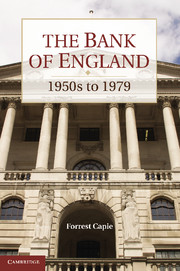Book contents
- Frontmatter
- Contents
- List of Illustrations
- List of Figures
- List of Tables
- Foreword by Mervyn King
- Preface
- Acknowledgements
- Abbreviations and Acronyms
- 1 Introduction and Overview
- 2 The Bank in the 1950s
- 3 The Monetary Setting and the Bank
- 4 The Bank's External Responsibilities to 1964
- 5 From Crisis to ‘Crucifixion’
- 6 Domestic Monetary Policy after Radcliffe
- 7 Other Activities and Performance
- 8 Sterling from Devaluation to Smithsonian
- 9 The Road to Competition and Credit Control
- 10 Competition and Credit Control
- 11 The Secondary Banking Crisis
- 12 Banking Supervision
- 13 Monetary Targets and Monetary Control
- 14 The Bank and Sterling in the 1970s
- 15 The Bank's Freedom to Operate
- 16 Epilogue
- Bibliography
- Index
- Titles in the series
13 - Monetary Targets and Monetary Control
Published online by Cambridge University Press: 05 July 2011
- Frontmatter
- Contents
- List of Illustrations
- List of Figures
- List of Tables
- Foreword by Mervyn King
- Preface
- Acknowledgements
- Abbreviations and Acronyms
- 1 Introduction and Overview
- 2 The Bank in the 1950s
- 3 The Monetary Setting and the Bank
- 4 The Bank's External Responsibilities to 1964
- 5 From Crisis to ‘Crucifixion’
- 6 Domestic Monetary Policy after Radcliffe
- 7 Other Activities and Performance
- 8 Sterling from Devaluation to Smithsonian
- 9 The Road to Competition and Credit Control
- 10 Competition and Credit Control
- 11 The Secondary Banking Crisis
- 12 Banking Supervision
- 13 Monetary Targets and Monetary Control
- 14 The Bank and Sterling in the 1970s
- 15 The Bank's Freedom to Operate
- 16 Epilogue
- Bibliography
- Index
- Titles in the series
Summary
It was inevitable that competition and credit control (CCC) would be followed by transitional problems, some anticipated and some less so. Monetary conditions were made more difficult when accompanied by the coincidental expansionary policies of the Heath Government. When exogenous shocks such as the oil-price rises and some attendant exchange-rate changes were added, they resulted in turmoil. The need to address monetary control intensified, and talk of monetary aggregates and targets then came increasingly to the fore and were finally made explicit and public in 1976. What was less clear was how firm the belief in them was or how strong the commitment to achieving them was. As far as tackling inflation went, the emphasis still was heavily on incomes policies. It was only after the advent of the new Conservative Government in 1979 that interest rates began to be used more aggressively.
Whereas the monetary variables had been remarkably steady for 100 years, in the 1970s there was wildly different behaviour. The money multiplier (M3) had been stable at close to 4 from 1870 to 1970, but after 1970 it rose abruptly and was almost 10 by 1981. The components of the multiplier that reflect the behaviour of the non-bank public and of the banking sector, respectively, followed different but relatively easily explained paths. There is not much to remark on for the banks' reserve-deposit (R/D) ratio. Since the Second World War, the minimum reserve requirement of 8 per cent imposed on the clearing banks remained until 1971.
- Type
- Chapter
- Information
- The Bank of England1950s to 1979, pp. 644 - 706Publisher: Cambridge University PressPrint publication year: 2010



